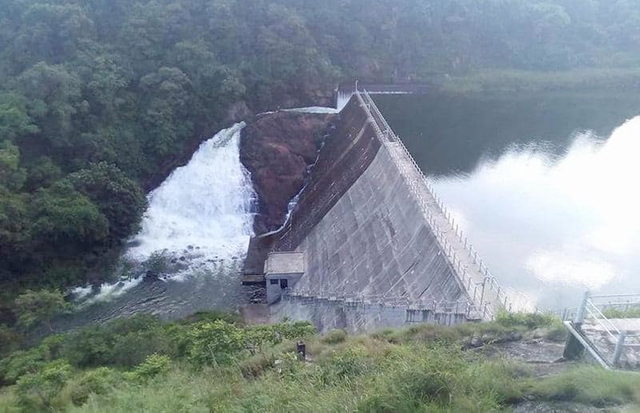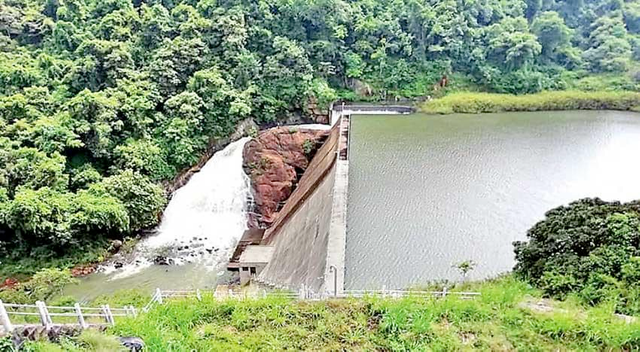Crossing the Nalanda stream
Nalanda Dam
- The dam was built seventy-three years ago
- The Duke of Edinburgh came to open
The Nalanda Reservoir in Matale District was opened in 1950 by the Duke of Edinburgh in a very beautiful environment. The commemorative mango tree he planted that day can still be seen at that place.
Nalanda Oya starts from the streams that flow from the peaks of Bilagala, Asgirikanda Makulussa, Ambokka, Arangala, etc., located northwest of Matale. Nalanda, Ausella etc fields are also fed from Nalanda Reservoir.

The first concrete dam reservoir in Sri Lanka was the Nalanda Reservoir built in 1950. It is an absolutely amazing irrigation design. The Nalanda Reservoir located in the Naula Regional Secretariat of the Matale District of the Central Province can be reached after traveling about 1.2 km on the southbound road near the 48 km post on the Kandy-Jaffna A9 route.
Mr. RP Weerasuriya, Dambulla District Irrigation Engineer in charge of Nalanda Reservoir in the Irrigation Department says that the catchment area of the reservoir is 48 square miles. The water from the reservoir is released into Wemadilla and Devahuwa reservoirs.
The people of the country know little about the first concrete irrigation dam in our country, which was inaugurated by the Duke of Edinburgh in England. The first is that it is the first reservoir with a concrete dam built by engineers in the history of irrigation in this country. Its water goes to Bovatthanna Reservoir and the power plant on one side, while Wemadilla Reservoir on the other side contributes to the fertility of fields in Matale and Anuradhapura areas.

It is a unique event that this reservoir was opened in 1950 in an extremely beautiful environment in Matale district by the Duke of Edinburgh in England. A commemorative mango tree planted by him can still be seen at that place.
Nalanda Oya starts from the streams flowing from mountain peaks like Bilagala, Asgirikanda Makulussa, Ambokka, Arangala etc. located in the northwest of Matale. Nalanda, Ausella and other fields which were built and cultivated during the Sinhalese kingdom are fed by Nalanda Reservoir.
There are many hidden stories about the great irrigation design that was built with the technical knowledge of the engineers of this country, demonstrating the amazingness of the irrigation techniques of the past. A family related to an incident where the Duke of Edinburgh who came to open the Nalanda Reservoir was presented with a bastam still lives in a village near the Nalanda Reservoir.
The Nalanda Reservoir supplies enough water to the paddies to work both the land and mud for three seasons a year. The Nalanda water lily, which silently travels long distances fertilizing the crops of many farmlands, becomes very beautiful during the rainy season. As well as the reservoir located in the lower valleys, this water flows to the Amban Ganga and Moragahakanda, and on the other side, from the Wemadilla Reservoir, it supplies the water to many lakes.
Apart from farming activities, the Nalanda Reservoir is also doing a great job in terms of providing drinking water as well as fishing activities.
The Nalanda Reservoir provides drinking water to five hundred families in the Nalanda area under the divisions operating under the Naula office of the National Water Supply and Water Transport Board. The aim is to repair the Nalanda Reservoir and take measures to retain more water in the reservoir, and thereby provide water for the upper part of the Hakwatuna Oya and Mee Oya watersheds by utilizing the Devahuwa fed stream through the Wemadilla Reservoir. Irrigation engineers are confident that it will be possible to cultivate the Yala river basin under the Hakwatuna Oya Reservoir.
It will also provide the opportunity to cultivate both seasons using 150 small tanks in the upper part of the Hakwatuna Oya and Mee Oya watersheds. It is also proposed to build 02 medium sized reservoirs in Mahakirula and Mahakitula areas in Kahalla, Pallekele reserve to effectively fulfill the water supply.
Under the second phase, a part of the water stored in the Moragahakanda-Kalugagana reservoir can be released to the lakes like Hurulu Lake and Nachchaduwa through the proposed upper canal, so that the water in these lakes can be limited by the Bowathenna reservoir.
It is planned to supply the restricted water to Wemadilla Reservoir through a weir constructed across Dambulu Oya, and water to Hakwatuna Oya and Mee Oya basin as mentioned in the 01st phase.
Because of this, 200 small tanks in the lower basin of Hakwatuna Oya and Mee Oya are expected to be planted in both seasons. The money needed for all the work of the Northwest Water Diversion Project is provided by the Asian Development Bank and the amount is 550 million US dollars.
One hundred and thirty one farmer families are fed by the water of the seventy-three year old Nalanda Reservoir. Alugolla Farmers Organization Chairman D.W. Mr. Abeykon Banda said that proper repairs have not been done in Nalanda Reservoir since many years, due to which the cultivated lands are not receiving water properly.
Although the farmers' organization has actively contributed to the repair of the field canals, the farmers' organization is of the opinion that there are problems in getting water from the reservoir.
"The dam that supplies water from this reservoir has not been renewed for many years. The canal is leaking water at many places. The dam, which is about three kilometers long, has been identified for restoration under international aid, but the restoration has not yet taken place. This business comes under minor irrigation and Mahaweliya is not working in this regard.
There are times when there is not enough water for cashew plantations during the spring season. What is actually happening is that an unnecessary amount of water is being wasted.”
The chairman of Alugolla Farmers' Organization D.W. Mr. Abeykon Banda's opinion.
People's Liberation Front
Downvoting a post can decrease pending rewards and make it less visible. Common reasons:
Submit